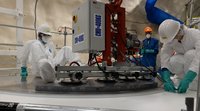Scientists estimate that dark matter makes up 85 percent of all mass in the Universe. Despite its presence, its nature remains elusive. Dark matter has mostly revealed itself through its gravitational influence on distant galaxies. Located two kilometers under earth’s surface in Sudbury, SNOLAB holds promise as an ideal location to investigate this elusive dark matter, as it blocks cosmic rays that bombard the Earth’s surface.
The SuperCDMS experiment is currently underway at the SNOLAB with researchers from around the world, including Europe and India, to study dark matter in the Universe. The experiment involves 24 palm-sized disks of silicon and germanium that are cooled down to a temperature no greater than three-hundredths of a degree above absolute zero. In this condition, the event of a single dark matter particle impacting an atomic nucleus is expected to create a ripple effect throughout the lattice. This disturbance would then interrupt the electric current flow within a superconducting material engraved onto the disk's surface. The experiment set-up focuses on reducing any possible source of background noise that could mask a signal.
The Department of Physics at the University of Toronto is a pivotal contributor to the SuperCDMS experiment, spearheaded by Professors Ziqing Hong, Pekka Sinervo, and Miriam Diamond, as well as Adjuncts Jeter Hall and Andrew Kubik. This collaborative team comprises 6 postdoctoral fellows, 10 graduate students, and numerous enthusiastic undergraduate students. The group is supported by the Arthur B McDonald Canadian Astroparticle Physics Research Institute and NSERC.
Prof. Miriam Diamond, a team member in the experiment and a physicist at the University of Toronto, said that data collected will be records of the crystal vibrations, similar to miniature earthquakes that move the needle on a seismograph.
“We have a template, which basically tells us what shape our signal event would be,” Dr. Diamond said. However, the existence of dark matter cannot be established by one signal. It will require significant accumulation of such events to make a positive result.
More information here: The new hunt for dark matter - The Globe and Mail

